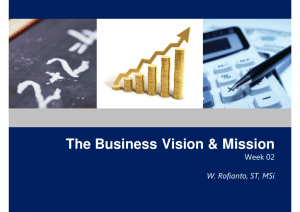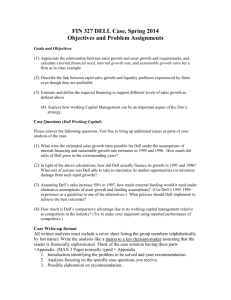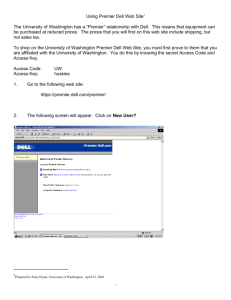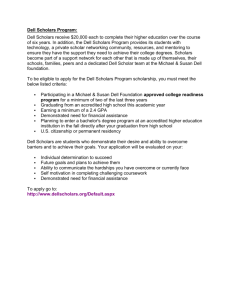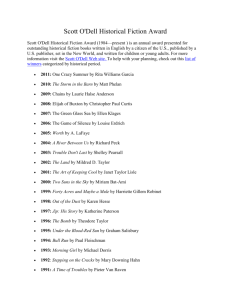1) Programmed Decision Making is routine, virtually automatic
advertisement
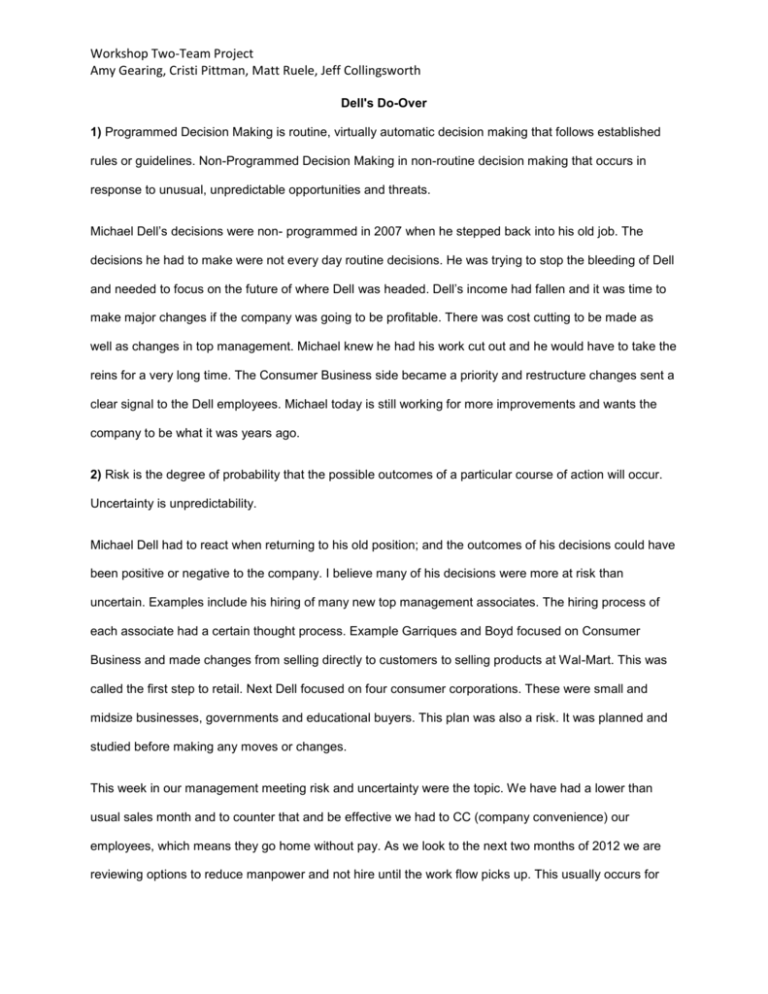
Workshop Two-Team Project Amy Gearing, Cristi Pittman, Matt Ruele, Jeff Collingsworth Dell's Do-Over 1) Programmed Decision Making is routine, virtually automatic decision making that follows established rules or guidelines. Non-Programmed Decision Making in non-routine decision making that occurs in response to unusual, unpredictable opportunities and threats. Michael Dell’s decisions were non- programmed in 2007 when he stepped back into his old job. The decisions he had to make were not every day routine decisions. He was trying to stop the bleeding of Dell and needed to focus on the future of where Dell was headed. Dell’s income had fallen and it was time to make major changes if the company was going to be profitable. There was cost cutting to be made as well as changes in top management. Michael knew he had his work cut out and he would have to take the reins for a very long time. The Consumer Business side became a priority and restructure changes sent a clear signal to the Dell employees. Michael today is still working for more improvements and wants the company to be what it was years ago. 2) Risk is the degree of probability that the possible outcomes of a particular course of action will occur. Uncertainty is unpredictability. Michael Dell had to react when returning to his old position; and the outcomes of his decisions could have been positive or negative to the company. I believe many of his decisions were more at risk than uncertain. Examples include his hiring of many new top management associates. The hiring process of each associate had a certain thought process. Example Garriques and Boyd focused on Consumer Business and made changes from selling directly to customers to selling products at Wal-Mart. This was called the first step to retail. Next Dell focused on four consumer corporations. These were small and midsize businesses, governments and educational buyers. This plan was also a risk. It was planned and studied before making any moves or changes. This week in our management meeting risk and uncertainty were the topic. We have had a lower than usual sales month and to counter that and be effective we had to CC (company convenience) our employees, which means they go home without pay. As we look to the next two months of 2012 we are reviewing options to reduce manpower and not hire until the work flow picks up. This usually occurs for Workshop Two-Team Project Amy Gearing, Cristi Pittman, Matt Ruele, Jeff Collingsworth the first few weeks of November then we get a surge of product to finish out the year. This is based on the past few years that we have studied. 3) For Michael Dell, the initial stimuli that caused him to make a decision to ask for his job as CEO of Dell back was the center of the tech industry had shifted from the PC to the Internet and Dell, the company, was struggling mightily to find its place. While HP, IBM and other rivals transformed themselves in recent years by acquiring new companies and capabilities, Dell long stuck with its old playbook of cranking out PCs as efficiently as possible. In 2005 Dell was valued at over $100 billion and today it is worth only 30 billion. A decision had to be made to keep the company competitive or let it go under. In addition the fact that the company was losing shares in the PC market it was also struggling with an investigation into its accounting practices. For these reasons the directors agreed and made the decision to replace the current CEO Kevin B. Rollins, who was handpicked by Michael Dells to succeed him as the CEO would now be replaced by Michael Dell himself. The first decision that was made was Michael Dell took the helm as CEO of Dell again. One at the helm, as CEO, he made it clear that he was determined to change almost everything about the company due to what he call a ginormous shift in the computer business over the last several years. Once Michael Dell installed almost a completely new management team there were managers that had to make decision. The stimuli that caused M. Dell to hire Ronald G Garriques, as head of Dell’s consumer division, was M. Dell had to stop the bleeding of the consumer business. Garriques recognized the need to make a decision to stop this bleeding and achieve the goal that was set before him by Michael Dell and that was to create a profitable consumer business with designs that rival Apple’s and HP’s. One of Garriques’ decision was to hire Ed Boyd, not to redesign the computers functions, but instead to make design matter at Dell, so that stimuli that propelled Boyd to make a decision was the fact that people wanted to convey a sense of personal style with their products. Next M. Dell wanted to change the companies’ management culture, so he hired Brian Gladden, a 20 year veteran of GE, to be the chief financial officer overseeing day-to-day operations. The stimuli that drove Gladden to recognize the need to make a decision was Dell’s processes, the tools, the culture didn’t support a $60 billion business, so he dove into figuring out how to change that. Workshop Two-Team Project Amy Gearing, Cristi Pittman, Matt Ruele, Jeff Collingsworth I felt they learned from the feedback back. Over all what M. Dell wanted to happen happened as a result of his making decisions. The proof is in their increase in stock prices doubling from a low in February to $16. Below are some specific examples where management’s decision allowed them to meet their expectations. Dell’s recent feedback while in an interview in his conference room he acknowledged he stuck with the one innovated idea of selling computers to long, but any talk of that now is nonsense. The right decisions are being made to move the company forward. The proof is in their increase in their stock shares too. Garriques’ feedback from the consumers is also positive. Dell is making its mark on the tech world with high tech and innovative Adamo XPS and others new product on the horizon. Boyd’s initial feedback from Dell’s manufacturing team wasn’t good, they bulked at the changes, but Boyd appealed directly to M. Dell, who gave the green light to move ahead, which has lead to a positive outlook for Dell as they broke for good with its tradition of selling only directly to the customer. They announced plans to sell it machines at Walmart in what the CEO called a “first step” in using retail stores to reach customers. Gladden saw his executive team quickly take to the new management approach, which was modeled after GE, so the feedback has been good. 4) M. Dell handpicked his new team based on their past performance and success as a manager, so I would say Michaels initial decision to change his management staff didn’t involve any satisfice elements at all. Once his team was built I think there was a certain amount of satisficing going on, for example when Dell would email Garriques and say, “Hey Ron, I was o this Web site, and wouldn’t it be cool if our products does this or does that? M. Dell knew what he wanted and actively searched out the candidates that fit the bill to a tee! I think many of the decisions had to be made with a certain amount of satisficing, because there technology was moving forward at a break neck speed and for Dell to stay in the game they had to rapidly deal with the risk and uncertainty. The fact of the matter is they were forging a new frontier in the PC and other high tech worlds and the managers had to search for and choose acceptable or satisfactory, ways to respond to problems and opportunities rather than trying to make the optimal decision. It is working for them. How I related Question 3 and 4 to my work place: I work for DoD AF and in that industry many of our decision are programmed until you hold a position that is at the strategic level. The strategic level is about Workshop Two-Team Project Amy Gearing, Cristi Pittman, Matt Ruele, Jeff Collingsworth broad, long-term goals, then there is the tactical level which covers the big projects or activities that move us toward achieving the goals established at the strategic level and then there is the level I am at, the operational level. This is the level the day to day process ensure we can achieve the established tactical objective. I recognize a decision needs to be made when I am not able to achieve the tactical objectives set out for me. My line of work is manpower and with the huge budget cuts we are facing across the DoD, there will be some decisions to be made that are a direct result of what was decided at the strategic and tactical levels. Because I will not be pressed for time, I feel I will be able to make solid decision and therefore will not have to rely heavily on satisficing. How Procter & Gamble Plans to Clean Up 1) Procter and Gamble is pursuing the Differentiation Strategy. The CEO of Procter and Gamble, A.G. Lafley, talks about how the operating margin has increased but they are still spending money on Research and Development to keep its competitive edge. Consumers, in the last few years, have traded down to private, off-name brands instead of name brands such as Procter and Gamble's Pampers and Tide. I feel in my workplace that the Differentiation Strategy is at work. Now we do not spend nearly the amount of money that Procter and Gamble or Pepsi-Cola spends but we do put some money into pamphlets, cards, and booklets. We feel that these are helpful tools that will help the costumer to understand our products. Most costumers feel better about a product if they have information in their hand that they can read more information on it. As far as advertising my organization does very little of that. All of my advertising comes directly out of my pocket. Now this helps cut operating cost to the costumer and also helps to put more money back into the custumer’s pocket. 2) A.G. Lafley talked about creativity and invention being a good thing but until you can connect with the customer, product or service wise, you do not have the innovation. Innovation is the key. The money that Procter and Gamble saves on advertising can be used for Research and Development. With the innovation of new products it brings new costumers into the stores and with successful innovation can come new categories. A.G. Lafley discussed failure. If a product line looks like it might fail, cancel it. Yes you’re going to lose money but it’s better to lose some money early then lose a lot latter. Procter and Workshop Two-Team Project Amy Gearing, Cristi Pittman, Matt Ruele, Jeff Collingsworth Gamble are always looking for acquisitions and back in the year 2000 they also set a goal to have partners for half of the new products which would save them a lot of money. In 2007 -2008, Procter and Gamble made that goal. Procter and Gamble is in the Global Market as it reaches more than 3 million consumers in the world’s marketplace. The insurance organization, Woodmen of the World Life Insurance Society, I work with has been around for 120 years, which means they have definitely been doing something right. With all that has happened over the last 120 years (at least five wars and/or conflicts, the great depression, to name a few), they have always found a way to survive. Now that to me is innovation. Even if we did do big time advertising and hand out millions of pamphlets, cards, and booklets, what it comes down to is personnel service. The most pride that we take is in how we serve our clients and the community. 3) P&G use several different corporate strategies to build a competitive advantage over its competitors. Vertical integration, related diversification, and international expansion with wholly owned foreign subsidiaries are all methods of corporate strategy for P&G. Vertical integration is demonstrated because P&G owns every stage in the vertical value chain: making the chemicals used in cleaning compounds, labels for the product containers and delivering the product to vendors. Related diversification strategy is established because P&G owns several consumer products divisions. These divisions work together to improve efficiency. For example, the disposable diaper and paper towel divisions share research and development information to improve both products. International expansion by wholly owned foreign subsidiaries is evident because P&G owns production plants in several countries: such as Brazil and India. P&G finds a need in a growing market and then forms a business partnership with that local company. They invest a major stake in this company and build a modern factory, in that county, to produce products for the local market. Proctor and Gamble and my employer, the Army National Guard, have the same primary business strategy of differentiation. Both companies spend millions of dollars each year on advertising to create a unique image for its product. These companies advertise on television, radio, newspapers and even NASCAR to persuade consumers their products are unique and the best value for your investment.



